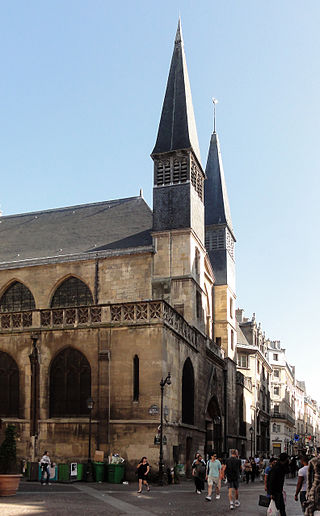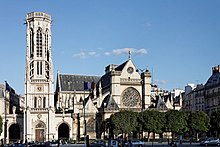
Saint-Nicolas du Chardonnet is a Catholic church in the centre of Paris, France, in the 5th arrondissement. It was constructed between 1656 and 1763. The facade was designed in the classical style by Charles Le Brun. It contains many notable art works from the 19th century, including a rare religious painting by Jean-Baptiste Corot.

Saint-Étienne-du-Mont is a church in Paris, France, on the Montagne Sainte-Geneviève in the 5th arrondissement, near the Panthéon. It contains the shrine of St. Geneviève, the patron saint of Paris. The church also contains the tombs of Blaise Pascal and Jean Racine. Jean-Paul Marat is buried in the church's cemetery.

The Church of Saint-Germain-des-Prés is a Roman Catholic parish church located in the Saint-Germain-des-Prés quarter of Paris. It was originally the church of a Benedictine abbey founded in 558 by Childebert I, the son of Clovis, King of the Franks. It was destroyed by the Vikings, rebuilt, and renamed in the 8th century for Saint Germain, a 6th century bishop. It was rebuilt with elements in the new Gothic style in the 11th century, and was given the earliest flying buttresses in the Ile-France in the 12th century. It is considered the oldest existing church in Paris.

The Church of St. Eustache, Paris, is a church in the 1st arrondissement of Paris. The present building was built between 1532 and 1633.

The Church of Saint-Séverin is a Roman Catholic church in the 5th arrondissement, or Latin Quarter, of Paris, on the lively tourist street Rue Saint-Séverin. It was constructed beginning in 1230, then, after a fire, rebuilt and enlarged in the 15th to 17th centuries in the Flamboyant Gothic style. It was the parish church for students at the University of Paris, and is one of the oldest churches that remains standing on the Left Bank.

Saint-Pierre de Montmartre is the second oldest surviving church in Paris, after the Abbey of Saint-Germain-des-Pres. It is one of the two main churches on Montmartre, the other being the more famous 19th-century Sacré-Cœur Basilica, just above it. Saint-Pierre de Montmartre, begun in 1133, was the church of the prestigious Montmartre Abbey, destroyed in the French Revolution.

The Église de la Sainte-Trinité is a Roman Catholic church located on the place d'Estienne d'Orves, at 3 rue de la Trinité, in the 9th arrondissement of Paris. It was built between 1861 and 1867 during the reign of Emperor Napoleon III, in the residential neighborhood of the Chaussée d'Antin. It is in the ornate Neo-Renaissance or Second Empire Style, with a highly visible 65-meter-tall belfry.

The Church of Saint-Merri or Église Saint-Merry) is a parish church in Paris, located near the Centre Pompidou along the rue Saint Martin, in the 4th arrondissement on the Rive Droite. It is dedicated to the 7th century abbot of Autun Abbey, Saint Mederic, who came to Paris on pilgrimage and later died there in the year 700. In 884 Mederic was declared patron saint of the Right Bank.

The Basilica of Saint Clotilde is a basilica church located on the Rue Las Cases, in the 7th arrondissement of Paris. It was constructed between 1846 and 1856, and is the first example of a church in Paris in the neo-Gothic style.

Saint-Louis en l'Île is a Roman Catholic parish church located at 19 Rue Saint-Louis en l'Île on Île Saint-Louis in the 4th arrondissement of Paris, France. It was constructed between 1664 and 1725, and is dedicated to King Louis IX of France, or Saint Louis. The church was originally built in the French Baroque style of the 17th century, but much of the interior decoration was taken or destroyed in the French Revolution. The church was extensively restored and redecorated in the 19th century.

The Église Saint-Augustin de Paris is a Catholic church located at 46 boulevard Malesherbes in the 8th arrondissement of Paris. The church was built between 1860 and 1871 by the Paris city chief architect Victor Baltard. It was the first church in Paris to combine a cast-iron frame, fully visible, with stone construction. It was designed to provide a prominent landmark at the junction of two new boulevards built during Haussmann's renovation of Paris under Napoleon III. The closest métro station is Saint-Augustin

The Church of Saint-Roch is a 17th–18th-century French Baroque and classical style church in Paris, dedicated to Saint Roch. It is located at 284 rue Saint-Honoré, in the 1st arrondissement. The current church was built between 1653 and 1740.

The Church of Saint-Nicolas-des-Champs is a Catholic church in Paris' Third arrondissement. Early parts of the church, including the west front, built 1420–1480, are in the Flamboyant Gothic style, while later portions, including the south portal, mostly built 1576–86, are examples of French Renaissance architecture. It is notable particularly for its Renaissance carved sculpture, decoration and large collection of French Renaissance paintings in the interior.

The Église Saint-Paul-Saint-Louis is a church on rue Saint-Antoine in the Marais quarter of Paris. The present building was constructed from 1627 to '41 by the Jesuit architects Étienne Martellange and François Derand, on the orders of Louis XIII of France. It was the first church in Paris to break away entirely from the Gothic style and to use the new Baroque style of the Jesuits, and it had an important influence on Parisian religious architecture. It gives its name to Place Saint-Paul and its nearest Metro station, Saint-Paul. Next door to the church is the Lycée Charlemagne, also founded by the Jesuits.

Saint-Thomas-d'Aquin is a Roman Catholic church located in the 7th arrondissement of Paris, place Saint-Thomas-d’Aquin, between the rue du Bac and the boulevard Saint-Germain. The church is named for Saint Thomas Aquinas, a Dominican friar and priest, and influential philosopher and theologian in the 13th century. It was originally a chapel of an abbey of the Dominican order in Paris. Construction began in 1682, and the church was consecrated in 1682. The friars were expelled and the church was closed during the French Revolution, and was not returned to the Catholic church until 1802. During the 19th century, the City of Paris endowed the church with many fine examples of French religious art. The church was declared an Historic Monument in 1982.

The Église Saint-Leu-Saint-Gilles de Paris is a Roman Catholic parish church in the 1st arrondissement of Paris. It has housed the relics of the Empress Saint Helena, mother of Constantine, since 1819, for which it remains a site of veneration in the Roman Catholic and Eastern Orthodox churches. In 1915 the French Ministry of Culture listed it as a monument of historical value.

Saint-Médard, Paris, is a Roman Catholic church located at 105 Rue Mouffetard in the 5th arrondissement of Paris. It takes its name from Saint Medard, the bishop of Noyon in northern France, who was protector of Queen Radegund, and helped her found a convent at Noyon to escape her abusive husband, King Chlothar I. Medard is the patron saint of French farmers.

Notre-Dame-de-la-Compassion is a Roman Catholic Church located on Place du Général Koenig in the 17th arrondissement in Paris. It was originally built in 1842–43 as a memorial chapel to Ferdinand Philippe, Duke of Orléans, the heir to King Louis-Philippe of France, who was killed in a road accident in 1842. It was built in the Neo-Byzantine style, with elements of Gothic, Baroque and other styles, and was originally called the Chapelle Royale Saint-Ferdinand. In 1970 it was moved stone by stone from its original location a short distance away to make space for the new Palais des Congrès. It became a parish church in 1993. Its notable decoration includes stained glass windows designed by Jean-Auguste-Dominique Ingres, and sculpture by Henri de Triqueti. It was designated a French historic monument in 1929.

The Église Saint-Philippe-du-Roule is a Roman Catholic church located at 154 Rue du Faubourg-Saint-Honoré in the 8th arrondissement of Paris. Resembling a Roman temple. it was built in the style of Neoclassicism between 1774 and 1784 by architect Jean-François Chalgrin best known for his design of the Arc de Triomphe. It was enlarged in 1845 by the architects Étienne-Hippolyte Godde and Victor Baltard.

The Church of Saint-Denys-de-Saint-Sacrament is a Roman Catholic church located in the Marais quarter, at 68 Rue de Turenne in the 3rd arrondissement of Paris, France. It was constructed between 1826 and 1835, It took its name from Saint Denys, the first bishop of Paris, and from the church of the Benedictines of the Perpetual Order of the Saint Sacrament, which had previously occupied the site. The early church was too small for the growing congregation and was replaced by the larger present church. It is an example of Neoclassical architecture, a style very popular in Paris the first half of the 19th-century.

































